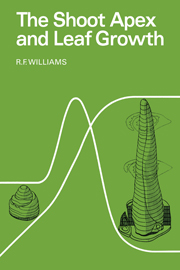7 - The growth of wheat tillers
Published online by Cambridge University Press: 04 August 2010
Summary
Long acquaintance with the wheat plant suggested that the genesis and growth of tiller buds might provide a suitable test system for the supposed effects of constraint on growth rates and on the genesis of form. Detailed accounts of collaborative work on this problem are currently being published (Williams et al. 1975; Williams and Langer, 1975), and a preliminary experiment involving both the removal of constraint and the application of additional constraint will be published by Williams and Metcalf (1975).
Drawings illustrating the initiation and early growth of the bud in the axil of leaf 2 are given in Fig. 4.7.3, and later stages for similar tillers appear as Figs. 7.1 and 7.2. The external shape of these early-stage tillers is entirely determined by their location. In Fig. 7.1 the tiller is shown in place and also removed at the level of its half-junction with the axis, thus revealing the snug cavity in which it is growing. In Fig. 7.2 the moulding is even more obvious, with a vertical dent to the right marking the position of the midrib of leaf 3. Note also that the first tiller leaf has the appearance of being extruded from between the margins of the prophyll, and a small piece of the inner margin of the leaf is actually caught between the outer margin and the prophyll.
The three-dimensional drawings are a little misleading visually because the removal of the relatively massive and slightly more mature tissues of the outer leaf sheath gives a false impression of freedom. The transverse sections of Fig. 7.3 (also Fig. 4.7.6 above) will counter such an impression; they also illustrate some additional features of the system.
- Type
- Chapter
- Information
- Shoot Apex and Leaf Growth , pp. 199 - 206Publisher: Cambridge University PressPrint publication year: 1975

